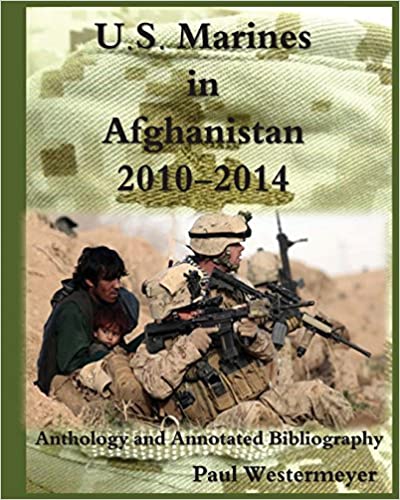
Reviewed by LTC Victor O. McGee, USA.
In October 2014, NATO and the U.S ended combat operations in Afghanistan; however the insurgency reformed and malign forces again were mounting stronger insurrections. Marines redeployed to Afghanistan to continue training Afghan Soldiers and Police Forces to counter act the rebellion.
This 6-part collection of 21 commentaries and personal encounters of Marines’ during their tours in Afghanistan from 2010-2014 can be consumed over a long weekend. But it is also a great read for spouses, family members, or Service Members preparing for deployment as it shows how Marines operate in the field. Contributing to the expression and collection of these commentaries is Paul W. Westermeyer. Paul is a historian for Marine Corps University and has published multiple works on the Marine Corps and military history. He also served as the editor of Desert Voices: An Oral History Anthology of Marines in the Gulf War (2016). His extensive knowledge of recent Marine Corps operations made him an excellent choice for authoring this book. Additionally, Christopher N. Blaker contributes his insight to the anthology while serving as an editor for Marine Corps University Press (MCUP).
When you begin to read this book, it is important to have a pad of paper handy so you can look up, research or make note of some weaponry, key dates, named operations, and how they correspond to current events. Readers will enjoy the use of regional military terminology developed in Iraq and Afghanistan to discuss and access local people, their environment, capabilities, equipment, and units. With the amount of information that must be transmitted in a short amount of time due to operational considerations, this developed terminology helps us better to understand the complexities of the operational environment and sets the foundation for the book’s storyline.
Part I begins by highlighting heroism and intense training to prepare the Afghanistan military and police forces to take over security for their nation. It continues by examining the progression of an idea, concept, and prototype of a revolutionary aircraft capable of taking off vertically like a helicopter and flying horizontal like a fighter jet, the MV-22 Osprey, which replaced the CH-46 Seahawk helicopter. Part I moves on to share with the reader how Marines broadened their autonomy in order to maintain an offensive posture while working to extend security in the region. Operation Steel Dawn II is a demonstration of the Marines at their best in battle as they, Afghan, and coalition forces kill insurgents, seize drugs, and confiscate weapons during a raid.
Part II provides great illustrations and photos for the visual learner backed up by storylines of President Obama’s guidance to U.S. Forces, with the Marines patrolling and establishing consistency of presence in Afghan villages. Combat camera photography and Marine Corps art collections add a characteristic military perspective and richness to the book’s storyline. Part III introduces the reader to a grotesque act by a Marine, which bruised the good reputation of the Marine Corps and jeopardized the good will of the Afghan people. Nevertheless, the resilient Marines remained focused and pushed through it, while quietly trying to figure out why a fellow Marine would perform such a repulsive act to another human being. Part IV, on 10 February 2013 Marine General Joseph F. Dunford Jr. enters the story to replace Marine General John R. Allen, Commander of the International Security Assistance Force (ISAF) and U.S. Forces Afghanistan and Senior American Commander in Afghanistan. General Dunford provides a fresh face to oversee Marines as they cycle down their training mission and cycle out of the South West Asian region. Part IV also follows up on Q&A interviews with four squared away Marines. This part was my favorite as it followed the unfortunate accounts of Part III and brought this book back into the daylight from darkness. In Part V, the book continues to provide great combat correspondence and imagery of operations to go with a new storyline of Marines confiscating narcotics to prevent Taliban from reaping profits. The story begins winding down in Parts V & VI by painting a closing image of the ending of combat operations, of scaling back on engagements and of POTUS addressing the troops.
This book provides a genuine look at Marines in the field and illuminates their grit, focus and their enduring bond with each other. As stated at the beginning, the anthology can be read by fellow warriors quickly or enjoyed over weeks with its multiple parts and commentaries. Moreover, this book is also well suited for a group setting; for example, a small group preparing for a deployment where they can examine and discuss the personal experiences each of the commentaries offers into the Marine culture. Thank you to Paul Westermeyer for compiling this much needed anthology of current culture and experiences in Afghanistan.
U.S. Marines in Afghanistan, 2010-2014: Anthology and Annotated Bibliography, by Paul Westermeyer. Government Printing Office (2017) & also St. John’s Press (2018). 311 pp.
Reviewed by LTC Victor O. McGee, US Army (Military Faculty, Joint Forces Staff College)
Pick up your copy today! amzn.to/2B8LNNW

